|
Weak Duality
In applied mathematics, weak duality is a concept in optimization which states that the duality gap is always greater than or equal to 0. This means that for any minimization problem, called the ''primal problem'', the solution to the primal problem is always greater than or equal to the solution to the dual maximization problem. Alternatively, the solution to a primal maximization problem is always less than or equal to the solution to the dual minimization problem. So, in short: weak duality states that any solution feasible for the dual problem is an upper bound to the solution of the primal problem. Weak duality is in contrast to strong duality, which states that the primal optimal objective and the dual optimal objective are ''equal''. Strong duality only holds in certain cases. Uses Many primal-dual approximation algorithms are based on the principle of weak duality.. Weak duality theorem Consider a linear programming problem, whe ... [...More Info...] [...Related Items...] OR: [Wikipedia] [Google] [Baidu] |
Applied Mathematics
Applied mathematics is the application of mathematics, mathematical methods by different fields such as physics, engineering, medicine, biology, finance, business, computer science, and Industrial sector, industry. Thus, applied mathematics is a combination of mathematical science and specialized knowledge. The term "applied mathematics" also describes the profession, professional specialty in which mathematicians work on practical problems by formulating and studying mathematical models. In the past, practical applications have motivated the development of mathematical theories, which then became the subject of study in pure mathematics where abstract concepts are studied for their own sake. The activity of applied mathematics is thus intimately connected with research in pure mathematics. History Historically, applied mathematics consisted principally of Mathematical analysis, applied analysis, most notably differential equations; approximation theory (broadly construed, ... [...More Info...] [...Related Items...] OR: [Wikipedia] [Google] [Baidu] |
Optimization
Mathematical optimization (alternatively spelled ''optimisation'') or mathematical programming is the selection of a best element, with regard to some criteria, from some set of available alternatives. It is generally divided into two subfields: discrete optimization and continuous optimization. Optimization problems arise in all quantitative disciplines from computer science and engineering to operations research and economics, and the development of solution methods has been of interest in mathematics for centuries. In the more general approach, an optimization problem consists of maxima and minima, maximizing or minimizing a Function of a real variable, real function by systematically choosing Argument of a function, input values from within an allowed set and computing the Value (mathematics), value of the function. The generalization of optimization theory and techniques to other formulations constitutes a large area of applied mathematics. Optimization problems Opti ... [...More Info...] [...Related Items...] OR: [Wikipedia] [Google] [Baidu] |
Duality Gap
In optimization problems in applied mathematics, the duality gap is the difference between the primal and dual solutions. If d^* is the optimal dual value and p^* is the optimal primal value then the duality gap is equal to p^* - d^*. This value is always greater than or equal to 0 (for minimization problems). The duality gap is zero if and only if strong duality holds. Otherwise the gap is strictly positive and weak duality holds. In general given two dual pairs separated locally convex spaces \left(X,X^*\right) and \left(Y,Y^*\right). Then given the function f: X \to \mathbb \cup \, we can define the primal problem by :\inf_ f(x). \, If there are constraint conditions, these can be built into the function f by letting f = f + I_\text where I is the indicator function. Then let F: X \times Y \to \mathbb \cup \ be a perturbation function such that F(x,0) = f(x). The ''duality gap'' is the difference given by :\inf_ (x,0)- \sup_ F^*(0,y^*)/math> where F^* is the convex ... [...More Info...] [...Related Items...] OR: [Wikipedia] [Google] [Baidu] |
Duality (optimization)
In mathematical optimization theory, duality or the duality principle is the principle that optimization problems may be viewed from either of two perspectives, the primal problem or the dual problem. If the primal is a minimization problem then the dual is a maximization problem (and vice versa). Any feasible solution to the primal (minimization) problem is at least as large as any feasible solution to the dual (maximization) problem. Therefore, the solution to the primal is an upper bound to the solution of the dual, and the solution of the dual is a lower bound to the solution of the primal. This fact is called weak duality. In general, the optimal values of the primal and dual problems need not be equal. Their difference is called the duality gap. For convex optimization problems, the duality gap is zero under a constraint qualification condition. This fact is called strong duality. Dual problem Usually the term "dual problem" refers to the ''Lagrangian dual problem'' but o ... [...More Info...] [...Related Items...] OR: [Wikipedia] [Google] [Baidu] |
Strong Duality
Strong duality is a condition in mathematical optimization in which the primal optimal objective and the dual optimal objective are equal. By definition, strong duality holds if and only if the duality gap is equal to 0. This is opposed to weak duality (the primal problem has optimal value smaller than or equal to the dual problem, in other words the duality gap is greater than or equal to zero). Sufficient conditions Each of the following conditions is sufficient for strong duality to hold: * F = F^ where F is the perturbation function relating the primal and dual problems and F^ is the biconjugate of F (follows by construction of the duality gap) * F is convex and lower semi-continuous (equivalent to the first point by the Fenchel–Moreau theorem) * the primal problem is a linear optimization problem * Slater's condition for a convex optimization problem. Strong duality and computational complexity Under certain conditions (called "constraint qualification"), if a ... [...More Info...] [...Related Items...] OR: [Wikipedia] [Google] [Baidu] |
Approximation Algorithm
In computer science and operations research, approximation algorithms are efficient algorithms that find approximate solutions to optimization problems (in particular NP-hard problems) with provable guarantees on the distance of the returned solution to the optimal one. Approximation algorithms naturally arise in the field of theoretical computer science as a consequence of the widely believed P ≠ NP conjecture. Under this conjecture, a wide class of optimization problems cannot be solved exactly in polynomial time. The field of approximation algorithms, therefore, tries to understand how closely it is possible to approximate optimal solutions to such problems in polynomial time. In an overwhelming majority of the cases, the guarantee of such algorithms is a multiplicative one expressed as an approximation ratio or approximation factor i.e., the optimal solution is always guaranteed to be within a (predetermined) multiplicative factor of the returned solution. However, there a ... [...More Info...] [...Related Items...] OR: [Wikipedia] [Google] [Baidu] |
Linear Programming
Linear programming (LP), also called linear optimization, is a method to achieve the best outcome (such as maximum profit or lowest cost) in a mathematical model whose requirements and objective are represented by linear function#As a polynomial function, linear relationships. Linear programming is a special case of mathematical programming (also known as mathematical optimization). More formally, linear programming is a technique for the mathematical optimization, optimization of a linear objective function, subject to linear equality and linear inequality Constraint (mathematics), constraints. Its feasible region is a convex polytope, which is a set defined as the intersection (mathematics), intersection of finitely many Half-space (geometry), half spaces, each of which is defined by a linear inequality. Its objective function is a real number, real-valued affine function, affine (linear) function defined on this polytope. A linear programming algorithm finds a point in the po ... [...More Info...] [...Related Items...] OR: [Wikipedia] [Google] [Baidu] |
Convex Optimization
Convex optimization is a subfield of mathematical optimization that studies the problem of minimizing convex functions over convex sets (or, equivalently, maximizing concave functions over convex sets). Many classes of convex optimization problems admit polynomial-time algorithms, whereas mathematical optimization is in general NP-hard. Definition Abstract form A convex optimization problem is defined by two ingredients: * The ''objective function'', which is a real-valued convex function of ''n'' variables, f :\mathcal D \subseteq \mathbb^n \to \mathbb; * The ''feasible set'', which is a convex subset C\subseteq \mathbb^n. The goal of the problem is to find some \mathbf \in C attaining :\inf \. In general, there are three options regarding the existence of a solution: * If such a point ''x''* exists, it is referred to as an ''optimal point'' or ''solution''; the set of all optimal points is called the ''optimal set''; and the problem is called ''solvable''. * If f is unbou ... [...More Info...] [...Related Items...] OR: [Wikipedia] [Google] [Baidu] |
Linear Programming
Linear programming (LP), also called linear optimization, is a method to achieve the best outcome (such as maximum profit or lowest cost) in a mathematical model whose requirements and objective are represented by linear function#As a polynomial function, linear relationships. Linear programming is a special case of mathematical programming (also known as mathematical optimization). More formally, linear programming is a technique for the mathematical optimization, optimization of a linear objective function, subject to linear equality and linear inequality Constraint (mathematics), constraints. Its feasible region is a convex polytope, which is a set defined as the intersection (mathematics), intersection of finitely many Half-space (geometry), half spaces, each of which is defined by a linear inequality. Its objective function is a real number, real-valued affine function, affine (linear) function defined on this polytope. A linear programming algorithm finds a point in the po ... [...More Info...] [...Related Items...] OR: [Wikipedia] [Google] [Baidu] |

